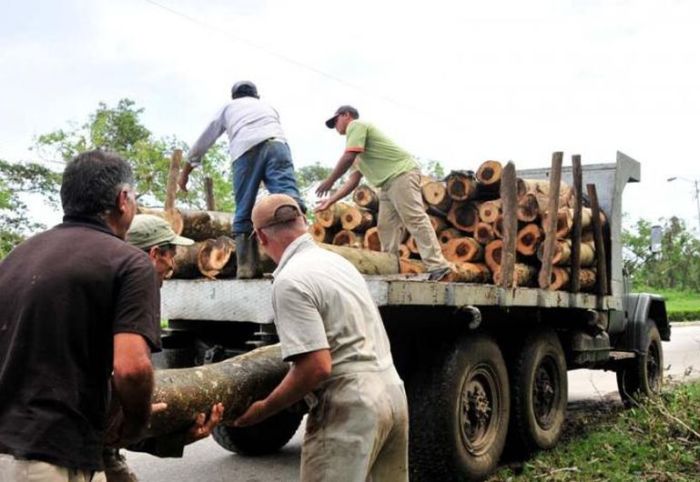
After Hurricane Irma, large quantities of timber have been collected in different areas of Sancti Spiritus
After the devastation brought by Hurricane Irma last September 9, the Ranchón El Bosque’s workers, next to the town of Meneses, could very well begin to look for another name for the facility.
Hurricane Irma Damages 80 Percent of Natural Forests in Sancti Spiritus
The center, ran by the Flora and Fauna Business and located in the middle of a picturesque grove of precious woods, miraculously saved its skin, but lost two of its most precious attributes: the surrounding vegetation and the permanent shade and freshness of the trees.
Maria Elvira Dávila Viamontes, director of the Unidad Empresarial de Base (UEB) Sancti Spiritus Norte, under the management of the Organización Superior de Dirección Empresarial para la Protección de la Flora y la Fauna, would like to have better news about the areas she controls, but even when she’s been unable to check all of them, she’s certain that after the disaster caused by Irma, at least 80 percent of the forest heritage was damaged.
Sancti Spiritus Norte is almost an understatement, because in addition to Jobo Rosado Protected Area (in the municipality of Yaguajay), the UEB also comprises the Lomas de Banao Ecological Reserve and the Tunas de Zaza Wildlife Refuge, both in the municipality of Sancti Spiritus, as well as Lomas de Fomento Floristic Reserve —in the Escambray Mountains—, and the Lebrije area, in Jatibonico. All these places were, in one way or another, hit by the storm.
It would seem that now the Flora and Fauna workers are jobless, but for the UEB leadership it’s quite the opposite, taking into consideration their commitment to recover what has been fostered and protected for many years, especially wood resources.
COFFEE GROWERS UPHILL
That Hurricane Irma’s winds would distroy the north of the country was presumed since the very moment that the Institute of Meteorology showed the first images and recommended Cubans to tighten their belts. But supposing that nearly 100 kilometers away from the hurricane center, near the south coast of the island, Topes de Collantes coffee plantations would also suffer the ravages of the storm was a magical realism thing.
Accelerating the harvest in some 1,300 hectares that were damaged, clearing the roads and rehabilitating the plantations crushed by the fall of the trees are the focus of the strategy of coffee workers, who in recent days received important reinforcements from the eastern territories of the country.
Brigades from the provinces of Granma, Holguín and Santiago de Cuba joined the agricultural workers of Fomento and Trinidad, especially to free crop cultivations from fallen branches and trees, a mission that also serves the strategy of saving wood for further use.
Leosvaldo Cruz Duardo, senior coffee specialist at the Delegación Provincial de la Agricultura, told reporters that it is now time to speed up the harvest and, of course, to accelerate the sanitation of damaged plantations so as not to step back in the national program designed to recover this product.
According to the expert, given the damages brought by the hurricane, it is necessary to reprogram the schedule for planting, replanting and treating the plantations, so as to seal areas and consolidate productive potentials, all of which will require multiplying nurseries and the work in the field.
IF CHAINSAWS ARE NOT ENOUGH …
When the guajiros of La Gasolinera, Siboney and La Garita —around Yaguajay— saw the palm trees lying beside the road, they first put their hands on their heads, but then they hurried up and began to get something out of misfortune.
The use of such trees for the construction of the so-called temporary facilities is just one of the advantages of the wood downed by the cyclone, not only because of the urgency of the affected people to have a roof overhead, but also because this is a long-lasting solution that for centuries has been tried in Cuban rural areas.
The damages to the forest heritage of the territory were so significant that forestry business authorities consider that in a matter of weeks, the entity could surpass the plan approved for the last quarter of the year, that amounts to 1 574 m³ of wood.
This statement has been supported by the wood deliveries made by Cabaiguán, Taguasco and El Cacahual, territories where only in a few days, more than 230 m³ were recovered and where it is said that when chainsaws are not enough, the workers do the job themselves with axes and machetes.
 Escambray ENGLISH EDITION
Escambray ENGLISH EDITION





Escambray reserves the right to publish comments.